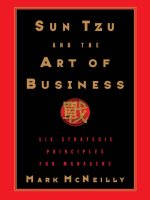consumers, producers, and the efficiency of markets
Bạn đang xem bản rút gọn của tài liệu. Xem và tải ngay bản đầy đủ của tài liệu tại đây (857.94 KB, 48 trang )
Principles of Economics
Session V
Consumers, Producers,
and the Efficiency of Markets
Overview
What is consumer surplus? How is it related to the
demand curve?
What is producer surplus? How is it related to the
supply curve?
Do markets produce a desirable allocation of resources?
Or could the market outcome be improved upon?
1
Learning Objectives
By the end of this session, students should
understand:
–the link between buyers’ willingness to pay for a
good and the demand curve.
–how to define and measure consumer surplus.
–the link between sellers’ costs of producing a good
and the supply curve.
–how to define and measure producer surplus.
–that the equilibrium of supply and demand
maximizes total surplus in a market.
2
3
Welfare Economics
Welfare economics studies how the allocation of
resources affects economic well-being.
The allocation of resources refers to:
–how much of each good is produced
–which producers produce it
–which consumers consume it
Part I
Willingness to Pay (WTP)
and Consumer Surplus
Consumers, Producers and the
Efficiency of the Market
5
Willingness to Pay (WTP)
A buyer’s willingness to pay for a good: the maximum
amount the buyer will pay for that good.
WTP measures how much the buyer values the good.
name WTP
John $250
Paul 175
George 300
Ringo 125
Example:
4 buyers’ Willingness-to-Pay
for an iPod
Source: Mankiw (2011)
6
WTP and the Demand Curve
Q: If price of iPod is $200, who will buy an iPod, and
what is quantity demanded?
A: John & George will buy an iPod,
Paul & Ringo will not.
Hence, Q
d
= 2
when P = $200.
name WTP
John $250
Paul 175
George 300
Ringo 125
7
WTP and the Demand Curve
Derive the demand schedule of iPod:
4
George, John,
Paul, Ringo
0 – 125
3
George, John,
Paul
126 – 175
2 George, John 176 – 250
1 George 251 – 300
0 nobody $301 & up
Q
d
who buys P (price)
name WTP
John $250
Paul 175
George 300
Ringo 125
8
WTP and the Demand Curve
$0
$50
$100
$150
$200
$250
$300
$350
0 1 2 3 4
P Q
d
$301 & up 0
251 – 300 1
176 – 250 2
126 – 175 3
0 – 125 4
P
Q
9
About the Staircase Shape…
$0
$50
$100
$150
$200
$250
$300
$350
0 1 2 3 4
P
Q
10
WTP and the Demand Curve
At any Q,
the height of
the D curve is
the WTP of the
marginal buyer
$0
$50
$100
$150
$200
$250
$300
$350
0 1 2 3 4
P
Q
George’s WTP
John’s WTP
Paul’s WTP
Ringo’s
WTP
11
Consumer Surplus (CS)
Consumer surplus : the amount a buyer is willing to
pay minus the amount the buyer actually pays:
CS = WTP – P
name WTP
John $250
Paul 175
George 300
Ringo 125
Suppose P = $260.
George’s CS = $300 – 260 = $40.
The others get no CS because they do
not buy an iPod at this price.
Total CS = $40.
12
CS and the Demand Curve
$0
$50
$100
$150
$200
$250
$300
$350
0 1 2 3 4
P
Q
George’s WTP
P = $260
George’s CS =
$300 – 260 = $40
Total CS = $40
13
CS and the Demand Curve
$0
$50
$100
$150
$200
$250
$300
$350
0 1 2 3 4
P
Q
George’s WTP
John’s WTP
Instead, suppose
P = $220
George’s CS =
$300 – 220 = $80
John’s CS =
$250 – 220 = $30
Total CS = $110
14
CS with Lots of Buyers & a Smooth
Demand Curve
0
10
20
30
40
50
60
0 5 10 15 20 25 30
P
Q
$
The demand for shoes
D
1000s of pairs
of shoes
Price
per pair
Source: Mankiw (2011)
15
CS with Lots of Buyers & a Smooth
Demand Curve
CS = ½ x 15 x $30
= $225.
0
10
20
30
40
50
60
0 5 10 15 20 25 30
P
Q
The demand for shoes
D
h
$
16
How a Higher Price Reduces CS
If P rises to $40,
CS = ½ x 10 x $20
= $100.
Two reasons for the
fall in CS.
0
10
20
30
40
50
60
0 5 10 15 20 25 30
P
Q
D
1. Fall in CS
due to buyers
leaving the market
2. Fall in CS due to
remaining buyers
paying higher P
17
0
5
10
15
20
25
30
35
40
45
50
0 5 10 15 20 25
P
Q
demand curve
A. Find marginal
buyer’s WTP at
Q = 10.
B. Find CS for
P = $30.
Suppose P falls to $20.
How much will CS increase
due to…
C. buyers entering
the market
D. existing buyers paying
lower price
$
Exercise V-1: Consumer Surplus
Part II
Cost, Supply Curve and
Producer Surplus
Consumers, Producers and the
Efficiency of the Market
20
Cost and the Supply Curve
Cost is the value of everything a seller must give up to
produce a good (i.e., opportunity cost).
–Includes cost of all resources used to produce good,
including value of the seller’s time.
Example: Costs of 3 sellers in the lawn-cutting business.
name cost
Jack $10
Janet 20
Chrissy 35
A seller will produce and sell the
good/service only if the
price exceeds his or her cost.
Hence, cost is a measure of
willingness to sell.
21
Cost and the Supply Curve
Derive the supply schedule from the cost data:
3 35 & up
2 20 – 34
1 10 – 19
0 $0 – 9
Q
s
P
name cost
Jack $10
Janet 20
Chrissy 35
22
Cost and the Supply Curve
$0
$10
$20
$30
$40
0 1 2 3
P
Q
P Q
s
$0 – 9 0
10 – 19 1
20 – 34 2
35 & up 3
23
Cost and the Supply Curve
$0
$10
$20
$30
$40
0 1 2 3
P
Q
At each Q, the
height of the S curve
is the cost of the
marginal seller
Chrissy’s
cost
Janet’s
cost
Jack’s cost
24
Producer Surplus
$0
$10
$20
$30
$40
0 1 2 3
P
Q
Producer surplus (PS):
the amount a seller
is paid for a good
minus the seller’s cost
PS = P – cost
Source: Mankiw (2011)
25
Producer Surplus and the Supply
Curve
$0
$10
$20
$30
$40
0 1 2 3
P
Q
PS = P – cost
Suppose P = $25.
Jack’s PS = $15
Janet’s PS = $5
Chrissy’s PS = $0
Total PS = $20
Janet’s
cost
Jack’s cost
Total PS equals the
area above the supply
curve under the price,
from 0 to Q.
Chrissy’s
cost









